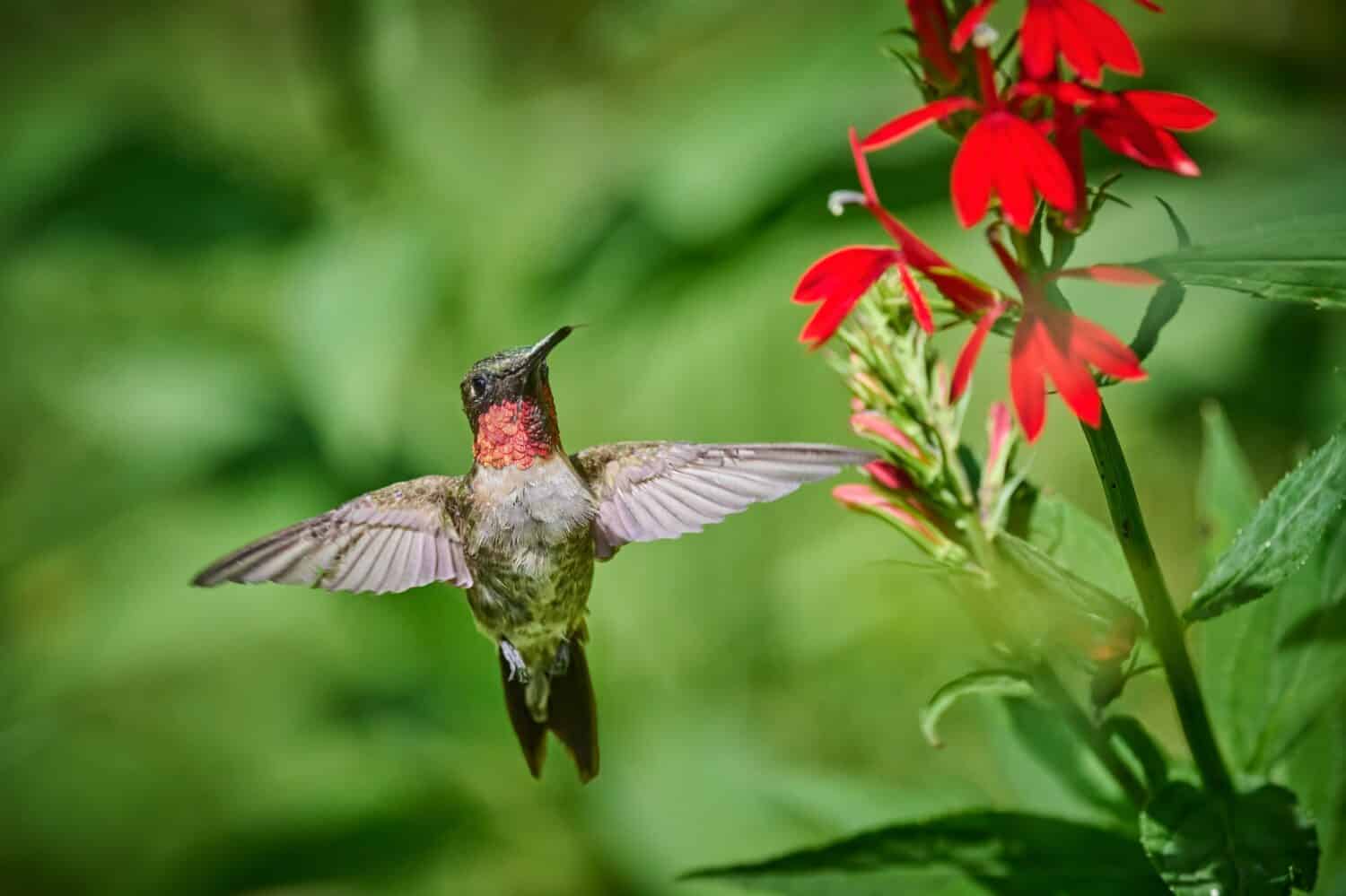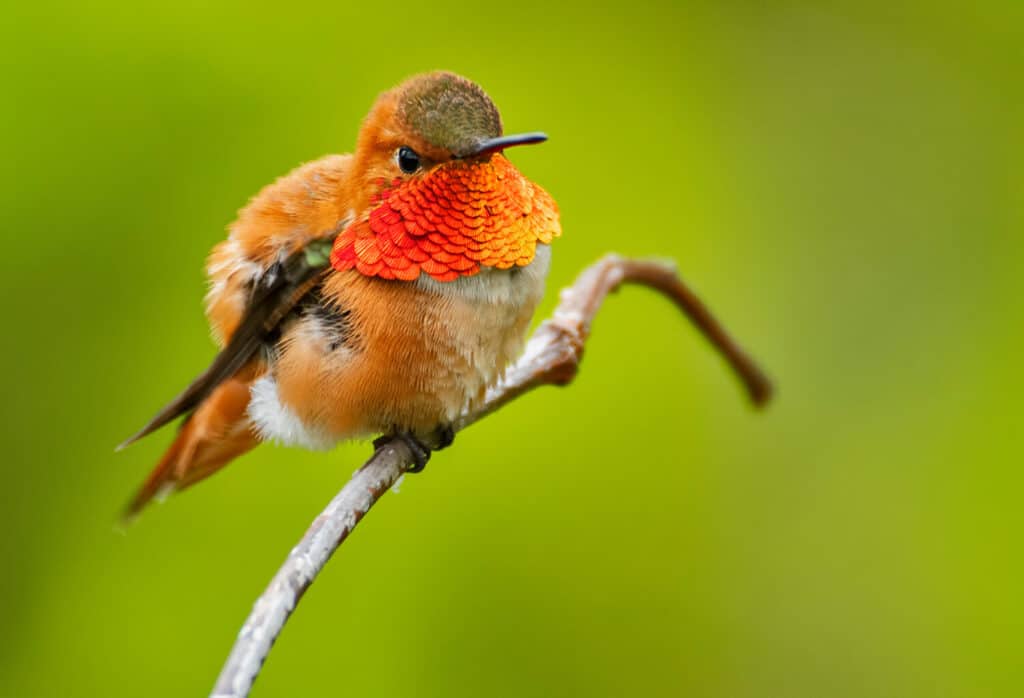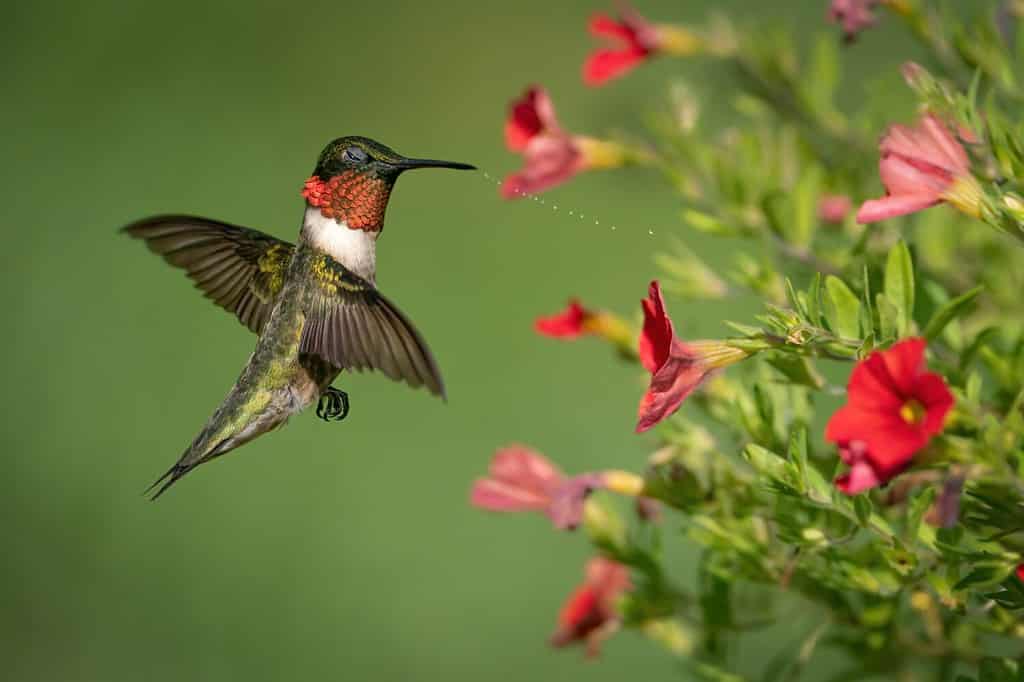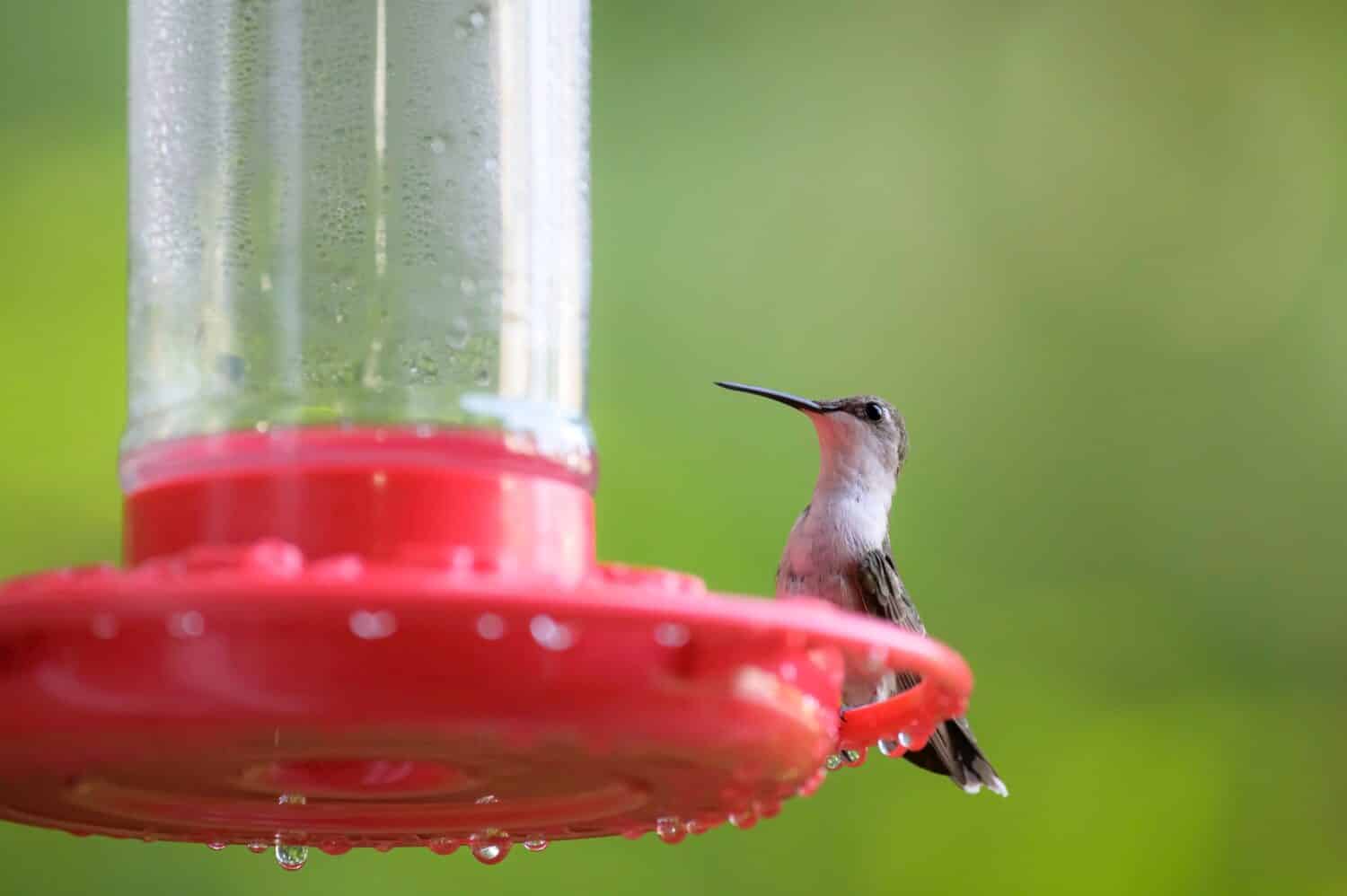Hummingbirds are some of the most beautiful and fascinating birds on the planet — they can even fly backward. Weighing only a few ounces due to their tiny skeleton, they are known for their astonishing agility and colorful feathers.
Native to the Americas, hummingbirds prefer mild climates and warmer areas. But one species calls Massachusetts home. Discover which hummingbirds live in the Bay State and when they leave for migration.
What Species of Hummingbirds Live in Massachusetts?

The name
hummingbird
comes from their wings’ humming sound when they fly.
©Patrick Jennings/Shutterstock.com
Common in the eastern United States, the ruby-throated hummingbird is the only hummingbird native to Massachusets, as it’s the only species known to breed in the state.
Adult males are characterized by their vibrant green plumage on their upper parts and brilliant ruby-red throat, which can appear black in certain lighting conditions. Adult females have pale underparts with greenish upperparts. They are solitary birds and only form flocks during migration.
The ruby-throated hummingbird is the most common species in the state. However, there have been occasional sightings of non-native Massachusetts hummingbirds, the Allen’s, black-chinned, calliope, and rufous hummingbirds. These sightings are rare, and often, they happen because an individual has veered off usual migratory routes.
When Do Hummingbirds Leave Massachusetts?

Colder temperatures can be dangerous for hummingbirds, hence their migration to the south.
©punkbirdr/Shutterstock.com
Around late summer and early fall, usually by September, hummingbirds start their remarkable migration from Massachusetts to warmer and more hospitable climates. The shortening daylight hours and the gradual drop in temperature act as nature’s cue for these tiny creatures to begin their journey southward.
Despite their minuscule size, hummingbirds are hardy and resilient travelers. Before leaving, they gather nectar from the final blossoms of the season and store energy for their long trip.
Where Do Hummingbirds Go Once They Leave Massachusetts?

Hummingbirds, the smallest birds on earth, are 3 to 5 inches long.
©Jiri Hrebicek/Shutterstock.com
Hummingbirds leave Massachusetts and other northern regions in response to the changing seasons. They embark on a migratory journey that takes them to more temperate and hospitable climates for the winter months. Their exact destinations vary depending on the hummingbird species, but generally, they head south to regions where food sources are more abundant and the temperatures suit their survival.
Massachusetts’ only native hummingbird species, the ruby-throated hummingbird, migrates to Central America for the winter. These birds fly across the Gulf of Mexico, covering over 500 miles non-stop. Their wintering grounds include countries like Mexico, Belize, Costa Rica, and other Central American nations. During the colder months, these countries offer plenty of nectar-producing flowers to feed on.
Other species of hummingbirds occasionally found in Massachusetts may migrate to different wintering areas along the western coast of North America, the southern United States, or Mexico.
These migratory journeys are genuinely remarkable, considering the tiny size of the birds. They rely on their impressive metabolism, efficient energy conservation techniques, and a strong instinct for navigation to successfully make their way to their wintering grounds.
When Do Hummingbirds Come Back to Massachusetts?

Hummingbirds migrate back north as soon as the blossoming season starts.
©Cavan-Images/Shutterstock.com
Hummingbirds return to Massachusetts and other northern regions in the spring. The exact timing of their return may vary based on weather patterns, temperature, and the availability of food sources.
It’s important to note that the return of hummingbirds to Massachusetts is closely tied to the availability of food sources. They rely heavily on nectar from flowering plants and insects for protein to sustain themselves during their migration and breeding season. As flowers bloom and insects become more active, hummingbirds find the nourishment they need to thrive.
The ruby-throated hummingbird’s return to Massachusetts is generally expected around late April to early May. As the days lengthen and temperatures rise, these tiny birds embark on their northward journey from their wintering grounds in Central America.
Do Hummingbirds Return to the Same Place Every Year in Massachusetts?

Male and female hummingbirds show site fidelity only if the site provides plentiful food.
©redtbird02/Shutterstock.com
Many hummingbirds exhibit site fidelity, returning to some general area year after year. This behavior is widespread for adult males, who are known to establish and defend territories that offer suitable food sources and nesting sites. They often return to the same yard, garden, or even specific flowering plants they’ve used in previous years.
This behavior is driven by a combination of factors, including their intimate knowledge of the local geography, remarkable memory, familiarity with the distribution of flowering plants, and the availability of suitable nesting locations.
While less likely to exhibit site fidelity, females may also return to familiar breeding grounds. But only if those areas provided successful nesting sites and ample food resources in the past.
Habitat changes, alterations in food availability, or competition from other hummingbirds can influence their decision to adjust their territories for better living conditions.
What Factors Affect the Hummingbirds’ Migration?

The arrival of the fall season is one of the main factors for the hummingbird migration.
©DrivingJack Photography/Shutterstock.com
Innate instincts, environmental cues, and physiological factors influence hummingbird migration. Several key factors play a role in shaping their migratory behavior.
Seasonal Changes
Hummingbirds are highly sensitive to changes in daylight length. As soon as the days shorten in the fall, hummingbirds migrate to warmer climates where food sources are more abundant.
Food Availability
As temperatures lower in Massachusetts, fewer flowers produce nectar, increasingly reducing the hummingbirds’ food source. While migrating, these birds seek out areas where flowering plants are still in bloom. For protein, they rely on insects, which become more difficult to find as temperatures drop.
Temperature and Climate
Cold temperatures can be hurtful to hummingbirds due to their small size and high metabolism. Maintaining their body temperature is crucial but challenging in colder climates. Hence, they migrate to regions with more favorable temperatures for their survival.
Elevation and Topography
Hummingbirds are known for exceptional navigation skills. Throughout their migration, they often follow specific migratory routes that take advantage of geographic features such as mountain ranges. The updrafts along these routes allow them to save energy during their long flights.
Genetic Programming
Hummingbirds have an inherited innate genetic programming that guides their migratory behavior. It influences the timing and direction of their migration.
Social Cues
While hummingbirds are generally solitary, they may still take other individuals’ cues to decide when and where to migrate.
Wind Patterns
Hummingbirds might be affected by wind patterns during their migration. They can alter their flight routes to take advantage of favorable winds or avoid strong headwinds.
Individual Variation
Not all hummingbirds within the same species will migrate at the same time. Their migration can start earlier or later depending on their age and variation in genetic programming.
Climate Change
If climate change affects humans, it is the same with hummingbirds. Changing climate patterns can affect food availability and blooming times, forcing the species to alter their migration route.
What Massachusetts Flowers Are Best for Attracting Hummingbirds?

Hummingbirds are particularly attracted to flowers with shades of red.
©Patrick Jennings/Shutterstock.com
To attract hummingbirds to your garden in Massachusetts, you must plant various flowers that provide nectar and vibrant colors. Here are some flower options that are well-suited for attracting hummingbirds:
- Bee Balm (Monarda spp.): Bee balm produces tubular flowers in red, pink, and purple shades. Its shape is perfect for the long bills of hummingbirds.
- Cardinal Flower (Lobelia cardinalis): This flower is a hummingbird’s favorite due to its vibrant red color and nectar-rich tubular blooms.
- Columbine (Aquilegia spp.): Hummingbirds are attracted to these columbine flowers and their unique shape. They come in multiple colors, including red, pink, and purple.
- Trumpet Vine (Campsis radicans): A vigorous climber with orange-red trumpet-shaped flowers.
- Scarlet Sage (Salvia coccinea): This plant offers bright red or coral flowers.
- Honeysuckle (Lonicera spp.): Certain species of honeysuckle produce tubular, sweet-scented flowers.
- Red Hot Poker (Kniphofia spp.): This plant features tall spikes of orange, red, or yellow flowers.
- Butterfly Bush (Buddleja spp.): Although not native, butterfly bush produces fragrant flower clusters in various colors that attract butterflies and hummingbirds.
- Foxglove (Digitalis purpurea): This biennial plant has tubular flowers in pink, purple, and white shades.
- Lupine (Lupinus spp.): These tall spikes of pea-like flowers come in various colors.
If you’re considering a hummingbird-friendly garden, consider planting a mix of flowers that bloom at different times throughout spring, summer, and early fall to provide a continuous nectar source. Native plants are often the best choice, as they have evolved to thrive in the local environment and provide natural food sources for native hummingbirds.
How to Make the Best Nectar to Attract Hummingbirds

Providing nectar to hummingbirds will encourage them to visit your garden.
©LHolmes Photography/Shutterstock.com
If you want to increase your chances of seeing hummingbirds in your garden, learn how to make the best nectar with only two ingredients, water and white granulated sugar. Here are the instructions for a nectar that hummingbirds will love.
Use the Correct Ratio
Using the proper ratio is essential to create nectar resembling the natural sucrose concentration found in the nectar of many flowers. Using a solution of one part sugar to four parts water is recommended.
Boil the Water
Boil the water to remove impurities and ensure the solution is clean for the hummingbirds.
Mix the Sugar
Add the appropriate amount of sugar once the water is boiled and still hot. Stir the solution until the sugar is completely dissolved.
For example, if you’re making one cup of nectar, mix in 1/4 cup of sugar.
Cool the Solution
Let the sugar water solution cool to room temperature. Do not put hot nectar in your feeder, as it can cause the feeder to warp or crack.
Fill and Hang the Feeder
Fill your hummingbird feeder with the cooled sugar water solution. Then, hang the feeder in a shady area. Make sure it is visible from a distance, as hummingbirds are likelier to visit it if they can spot it easily.
Clean and replace the nectar every three to four days and more frequently during warmer months.
Avoid Red Food Coloring
The red color is attractive to hummingbirds, but adding food coloring can be harmful to them. If you want to increase your chances of seeing them using your feeder, buy a feeder with red parts.
Hummingbirds are some of the most beautiful birds in the world. Even with their tiny body, they have shown incredible agility, remarkable navigation, and memory skills. Native to the Americas, they can be observed in the United States during the warmer months before traveling south to survive during the winter.
With a three- to five-year lifespan, every opportunity should be taken to observe these magnificent and precious birds. They are a beautiful sight to see and welcome in your backyard.
The photo featured at the top of this post is © Ondrej Prosicky/Shutterstock.com
Thank you for reading! Have some feedback for us? Contact the AZ Animals editorial team.







